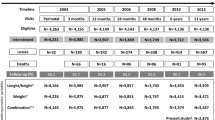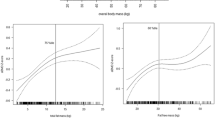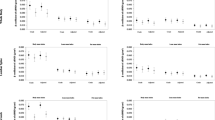Abstract
Fat mass was recently shown to be a positive determinant of bone mass and size independently of lean mass in a birth cohort of British 9-year-olds. The present study was undertaken to investigate whether similar relationships are evident in younger, preschool children. Height and weight were measured, and a total-body dual-energy X-ray absorptiometric scan was performed on 194 preschool New Zealand children (81 girls, 113 boys) participating in the Dunedin birth cohort Family, Lifestyle, Activity, Movement, and Eating (FLAME) study close to their fifth birthday. Relationships of total-body fat mass and lean mass to total-body-less-head (TBLH) bone area and TBLH bone mineral content (BMC) were evaluated using linear regression. Girls had higher mean fat mass (3.9 vs. 3.2 kg) and lower lean mass (14.5 vs. 15.2 kg) than boys (P < 0.001), but their heights, weights, and TBLH bone area were similar. Although a given weight of lean tissue was associated with greater increases in TBLH area than a given weight of fat tissue, our results show that fat mass was an independent predictor of TBLH bone area (R 2 = 0.79, P < 0.001) and TBLH BMC (R 2 = 0.74, P < 0.001) in data adjusted for socioeconomic status, ethnic group, lean mass, and height. We conclude that increased fat mass is associated with outward expansion of the TBLH skeletal envelope (wider bones) independently of height and lean mass in very young children.

Similar content being viewed by others
References
Wang Y, Lobstein T (2006) Worldwide trends in childhood overweight and obesity. Int J Pediatr Obes 1:11–25
Ministry of Health (2003) NZ food NZ children: key results of the 2002 National Children’s Nutrition Survey. Ministry of Health, Wellington
Turnbull A, Barry D, Wickens K et al (2004) Changes in body mass index in 11–12-year-old children in Hawkes Bay, New Zealand (1989–2000). J Paediatr Child Health 40:33–37
Miller JC, Grant AM, Drummond BK et al (2007) DXA measurements confirm that parental perceptions of elevated adiposity in young children are poor. Obesity 15:165–171
Leonard MB, Shults J, Wilson BA et al (2004) Obesity during childhood and adolescence augments bone mass and bone dimensions. Am J Clin Nutr 80:514–523
Wang Q, Alen M, Nicholson P et al (2007) Weight-bearing, muscle loading and bone mineral accrual in pubertal girls—a 2-year longitudinal study. Bone 40:1196–1202
Goulding A, Jones IE, Taylor RW et al (2000) More broken bones: a 4-year double cohort study of young girls with and without distal forearm fractures. J Bone Miner Res 15:2011–2018
Skaggs DL, Loro ML, Pitukcheewanont P et al (2001) Increased body weight and decreased radial cross-sectional dimensions in girls with forearm fractures. J Bone Miner Res 16:1337–1342
Davidson PL, Goulding A, Chalmers DJ (2003) Biomechanical analysis of arm fracture in obese boys. J Paediatr Child Health 39:657–664
Goulding A, Grant AM, Williams SM (2005) Bone and body composition of children and adolescents with repeated forearm fractures. J Bone Miner Res 20:2090–2096
Clark EM, Ness AR, Bishop NJ et al (2006) Association between bone mass and fractures in children: a prospective cohort study. J Bone Miner Res 21:1489–1495
Javaid MK, Lekamwasam S, Clark J et al (2006) Infant growth influences proximal femoral geometry in adulthood. J Bone Miner Res 21:508–512
Reid IR (2002) Relationships among body mass, its components, and bone. Bone 31:547–555
Oshima K, Nampei A, Matsuda M et al (2005) Adiponectin increases bone mass by suppressing osteoclast and activating osteoblast. Biochem Biophys Res Commun 331:520–526
Reid IR, Cornish J, Baldock PA (2006) Nutrition-related peptides and bone homeostasis. J Bone Miner Res 21:495–500
Lee NK, Sowa H, Hinoi E et al (2007) Endocrine regulation of energy metabolism by the skeleton. Cell 130:456–469
Specker BL, Johannsen N, Binkley T et al (2001) Total body bone mineral content and tibial cortical bone measures in preschool children. J Bone Miner Res 16:2298–2305
Pollock NK, Laing E, Baile CA et al (2007) Is adiposity advantageous for bone strength? A pQCT study in late adolescent females. Am J Clin Nutr 86:1530–1538
Zhao L-J, Liu Y-J, Hamilton LH et al (2007) Relationship of obesity with osteoporosis. J Clin Endocrinol Metab 92:1640–1646
Ackerman A, Thornton JC, Wang J et al (2006) Sex difference in the effect of puberty on the relationship between fat mass and bone mass in 926 healthy subjects, 6 to l8 years old. Obesity 14:819–825
Janicka A, Wren TAL, Sanchez MM et al (2007) Fat mass is not beneficial to bone in adolescents and young adults. J Clin Endocrinol Metab 92:143–147
Hind K, Burrows M (2007) Weight-bearing exercise and bone mineral accrual in children and adolescents: a review of controlled trials. Bone 40:14–27
Tobias JH, Steer CD, Mattocks CG et al (2007) Habitual levels of physical activity influence bone mass in 11-year-old children from the United Kingdom: findings from a large population-based cohort. J Bone Miner Res 21:101–109
Goulding A, Taylor RW, Jones IE et al (2000) Overweight and obese children have low bone mass and area for their weight. Int J Obes 24:627–632
Petit MA, Beck TJ, Shults J et al (2005) Proximal femur bone geometry is appropriately adapted to lean mass in overweight children and adolescents. Bone 36:568–576
Elefteriou F, Ahn JD, Takeda S et al (2005) Leptin regulation of bone resorption by the sympathetic nervous system and CART. Nat Clin Pract Rheumatol 434:514–520
Cornish J, Callon KE, Bava U et al (2002) Leptin directly regulates bone cell function in vitro and reduces bone fragility in vivo. J Endocrinol 175:405–415
Rosen CJ, Bouxsein ML (2006) Mechanisms of disease: is osteoporosis the obesity of bone? Nat Clin Pract Rheumatol 2:35–43
Shen W, Chen J, Punyanitya M et al (2007) MRI-measured bone marrow adipose tissue is inversely related to DXA-measured bone mineral in Caucasian women. Osteoporos Int 18:641–647
Zhao L, Jiang H, Papasian CJ et al (2008) Correlation of obesity and osteoporosis—effect of fat mass on the determination of osteoporosis. J Bone Miner Res 23:17–29
Young D, Hopper JL, Macinnis RJ et al (2001) Changes in body composition as determinants of longitudinal changes in bone mineral measures in 8 to 26-year-old female twins. Osteoporos Int 12:506–515
Garnett SP, Hogler W, Blades B et al (2004) Relation between hormones and body composition, including bone, in prepubertal children. Am J Clin Nutr 80:966–972
Crabtree NJ, Kibirige JN, Fordham JN et al (2004) The relationship between lean body mass and bone mineral content in paediatric health and disease. Bone 35:965–972
Clark EM, Ness AR, Tobias JH et al (2006) Adipose tissue stimulates bone growth in prepubertal children. J Clin Endocrinol Metab 91:2534–2541
Clark EM, Ness A, Tobias JH et al (2005) Social position affects bone mass in childhood through opposing actions on height and weight. J Bone Miner Res 20:2082–2089
Wosje KS, Knipstein BL, Kalkwarf HJ (2006) Measurement error of DXA: interpretation of fat and lean mass changes in obese and non-obese children. J Clin Densitom 9:335–340
Goulding A, Jones IE, Taylor RW et al (2001) Bone mineral density and body composition in boys with distal forearm fractures: a dual-energy X-ray absorptiometry study. J Pediatr 139:509–515
Taylor A, Konrad PT, Norman ME et al (1997) Total body bone mineral density in young children: influence of head bone mineral density. J Bone Miner Res 12:652–655
Brismar TB, Lindgren A, Ringertz H et al (1998) Total body bone mineral measurements in children with Prader-Willi syndrome: the influence of the skull’s bone mineral content per area (BMA) and of height. Pediatr Radiol 28:38–42
Rauch F (2007) Bone accrual in children: adding substance to surfaces. Pediatrics 119(Suppl2):S137–S140
Goulding A, Taylor RW, Jones IE et al (2003) Body composition of 4 and 5-year old New Zealand girls: a DXA study of initial adiposity and subsequent 4-year fat change. Int J Obes 27:410–415
Ellis KJ (1997) Body composition of a young, multiethnic, male population. Am J Clin Nutr 66:1323–1331
Ellis KJ, Abrams SA, Wong WW (1997) Body composition of a young, multiethnic female population. Am J Clin Nutr 65:724–731
Arabi A, Tamim H, Nabulsi M et al (2004) Sex differences in the effect of body-composition variables on bone mass in healthy children and adolescents. Am J Clin Nutr 80:1428–1435
Taylor RW, Gold E, Manning P et al (1997) Gender differences in body fat content are present well before puberty. Int J Obes 21:1082–1084
Klein KO, Baron J, McDonnell DP et al (1994) Estrogen levels in childhood determined by an ultrasensitive recombinant cell bioassay. J Clin Invest 94:2475–2480
Samra HA, Specker B (2007) Walking age does not explain term versus preterm difference in bone geometry. J Pediatr 151:61–66
Acknowledgements
We are very grateful to all the children and families participating in the FLAME study and thank Aveen Hewitt, Shirley Jones, and Tina Forrester for excellent technical assistance. The study was funded by grants from the Child Health Research Foundation of New Zealand, the National Heart Foundation of New Zealand, and the Caversham Foundation.
Author information
Authors and Affiliations
Corresponding author
Rights and permissions
About this article
Cite this article
Goulding, A., Taylor, R.W., Grant, A.M. et al. Relationship of Total Body Fat Mass to Bone Area in New Zealand Five-Year-Olds. Calcif Tissue Int 82, 293–299 (2008). https://doi.org/10.1007/s00223-008-9121-x
Received:
Accepted:
Published:
Issue Date:
DOI: https://doi.org/10.1007/s00223-008-9121-x




